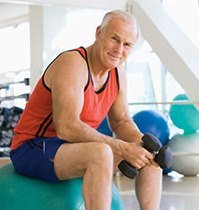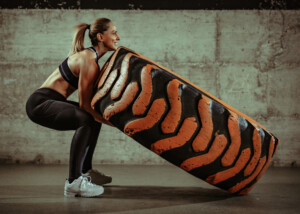Can you be too old to flip a tire for exercise? Is tire flipping more dangerous than beneficial for elderly people?
It’s a broad statement that needs a few qualifiers, but here it is:
For people over age 65? Yes, they should flip a tire for exercise.
Of course, you can’t just randomly pluck any old-age individual off the street and have them move a heavy tire, any more than you should expect the random old person to perform a barbell deadlift.
The weight of the load is also a very important consideration.
Reasons Tire Flipping May Seem Unsafe for Older People
This exercise is associated with competitions involving muscled younger people.
Big tires are associated with giant tractors or farm equipment. They’re seen in piles at junkyards. Tire shops smell. You get the picture.
BUT … a tire is a marvelous whole-body exercise tool.
Some gyms provide only tires that are way too heavy for an older person to work with, so it never dawns on them that the movement of tire flipping can vastly benefit their bodies.
But as tire flipping has become more popular as a fitness exercise rather than just for competition, more and more gyms are providing lightweight, smaller tires – including stationary tires that can be flipped back and forth in the same spot.
How can tire flipping benefit the aging body?
Many muscles are worked at the same time, in coordination with each other.
This mimics daily movement patterns that an elderly person might end up doing, such as caring for a spouse or just basic housework.
If an older person becomes trained at tire flipping, this will have significant carryover to the activities of daily living that, for many in the aged, out-of-shape population, create problems.
• Yardwork, gardening
• Getting in and out of motor vehicles
• Unexpected activities such as lifting or carrying a child or dog, placing a preschooler in a child safety car seat, bringing in a delivered package, shoveling snow, and loading and unloading merchandise from a vehicle.
The movements involved in tire flipping can be broken down into the same components that people perform through daily living.
Imagine how efficient Grandma would be at cleaning the house and placing a grandchild in and out of a high chair if she’d been flipping tires for the past several months. Picking up her grandchildren would be a breeze.
When It May Be Unsafe
With the deadlift, back squat and kettlebell swing, the spine moves in a linear path.
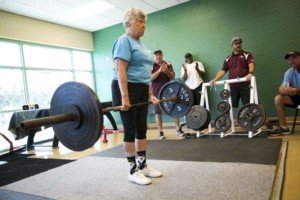
Trudy Daxon at 83, deadlifting 160 pounds. Credit: Tampabay.com
However, the tire flip requires it to, in addition to a linear path, also move forward, creating more instability.
Even a stationary tire flip device requires some forward movement to get the implement to tip over to the other side.
The user will place even more stress on the low back if they bend over more than they need to in order to move the weight, and/or if they let their lower back round out.
These rules also apply to the deadlift and squat, and even younger novices should adhere to strict form to prevent strain or injury.
But risk of injury is no reason to avoid this exercise, even if you’re “old.”
An old person risks injury riding a bicycle around the block, too. They risk injury playing golf, walking on an icy parking lot or carrying a potted plant down the stairs.
In fact, compared to many activities of daily living, flipping a tire is actually safer when done with mindfulness.
Tire flipping is a controlled, methodical activity, done slowly on a dry, flat surface.
Unless an older person has been instructed by their physician not to be bent against resistance due to spinal pathology, or not to squat due to knee joint disease, this exercise can be quite safe – safer in some ways than an aerobics class where one can stumble and fall.
Preparing the Elderly Beginner for Tire Flips
One should be able to perform a body weight half-squat without pain or difficulty, while keeping both feet flat on the floor.
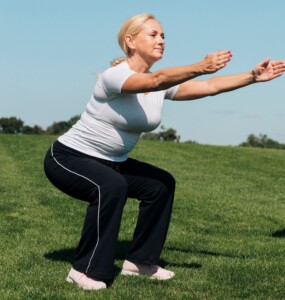
Freepik.com
If this is not possible, it will be difficult to get into the position required to lift the tire at the start of the movement.
The beginning of the tire flip should start from a stable squat position.
Pain in the knee or low back during a body weight squat are disqualifiers.
Another issue that may be overlooked is inner-thigh flexibility. A barbell squat or deadlift can be performed with the stiffest inner thigh muscles.
In these two exercises, the feet can also be only shoulder width apart or even less.
But to get positioned for a tire flip, one must place their feet (and therefore legs) out further, and then squat down. There must be room for the tire to “fit” between the upper thighs.
To then rise up requires butt muscle (glutes) activation, plus engagement of the glute-hamstring tie-in.
Many people, including younger, are deficient in this area, and compensate when rising from a squatting position by lifting their butt higher than their shoulders, relieving the glutes and glute-hamstring tie-in of recruitment.
This habit, which is commonly done by the average person rising from a squatting position after, for instance, checking a car tire or doing some gardening, signifies a weak glute-hamstring tie-in plus weak glutes.
You can’t have this problem when tire flipping, as it will impede safe form.
In short, painlessly nailing body weight squats with perfect form is a requirement.
Additional preparation would be other strength training exercises such as the ones shown below.

Leg press. Shutterstock/Wendy M. Simmons
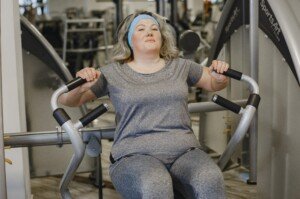
Chest press. Pexels, Gustavo Fring

Kettlebell swing. Shutterstock/gpointstudio
The other prerequisiste is the absence of shoulder problems. If you have a tweaky rotator cuff, this will interfere with pushing over a heavy tire.
In fact, even tendonitis in the elbow will get in the way. So make sure you’re cleared of these issues before embarking on tire flipping.
Gripping the Tire
Grip may be a problem for many older people, but the smaller the tire, the less of an issue this will be. As you become stronger with this exercise, your grip will become more efficient.
You may be wondering about wearing weightlifting gloves. These will certainly help with traction.
However, I don’t recommend them simply because these create an unnatural lifting environment.
What if in real life you must combine a good grip with resistance? If you’re used to wearing gloves at the gym, then your grip won’t be efficient in a real life situation. Ditch the gloves.
Part of tire flipping is strengthening a weak grip. Performing deadlifts and other pulling movements (seated row, dumbbell bent-over row) will add strength to your grip.
Getting Out of Breath
Flipping a light tire across a room can get an older person quickly out of breath.
The goal should be strength training — building strength throughout your entire body — rather than endurance across a long strip at a gym.
There’s a psychological component to consider: the dread of having to flip that tire “all the way to the other side.”
One can become very winded before they even know it when flipping a tire for distance.
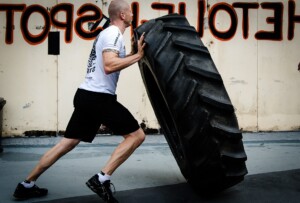
This isn’t about distance (duration); it’s about strength training.
Treat tire flipping as a weightlifting exercise. A good repetition range with classic weightlifting moves for fitness and strength is six to 10. The tire flip is the same.
For elderly people who want to be stronger and fitter, there’s no need to flip a tire more than 10 times in a row.
If you’re new to strength training, it’d be wise to spend several weeks getting your muscles used to training against resistance by working your upper and lower body out with machines and free weights, before moving on to tire training.

